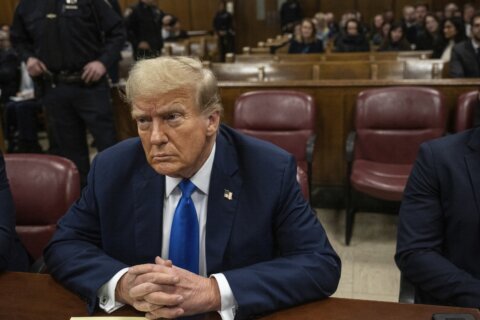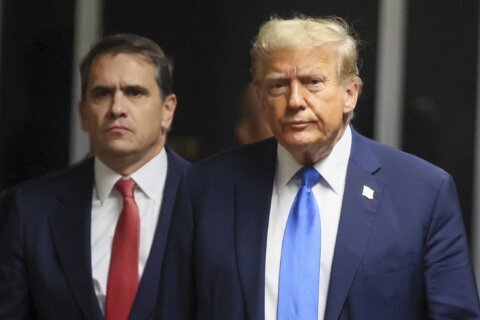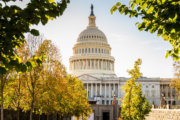▶ Watch Video: White and Black church congregants transformed by racial reconciliation program
When the Zoom meeting started on a mid-March evening from the Chicago suburb of Wheaton, Illinois, the six Black people and five White people came ready to begin an honest and difficult conversation.
“I want to be an anti-racist,” one White participant said. “I come humbly knowing I have a lot to learn.”
It was a baby-step, cordial and cautious. It also signaled a willingness to go deeper.
It was the beginning of a series of focused discussions on race between members of Bethel New Life, a predominantly Black church, and Hope Presbyterian Church, whose members are mostly White. For nearly six years, the two congregations have shared the same worship space in the affluent suburb.
As the night went on, people looking into their cameras relaxed and truths slowly emerged.
 Members of the predominantly Black Bethel New Life Church and Hope Presbyterian Church, whose congregants are mostly White, say they have been transformed by the “Be the Bridge” racial reconciliation program. The churches share the same space in Wheaton, Ill.
Members of the predominantly Black Bethel New Life Church and Hope Presbyterian Church, whose congregants are mostly White, say they have been transformed by the “Be the Bridge” racial reconciliation program. The churches share the same space in Wheaton, Ill.
Jennifer Taylor
Like the time when Bethel members held a cultural food festival during Black History Month. As the Hope’s church service let out, members were invited to taste dishes such as black-eyed peas, greens and cornbread. But like so many other worship days, the two congregations politely passed each other in the lobby, going about their day.
“Nobody came in,” said a member of Bethel New Life about that day. “I couldn’t remember if I was angry. I couldn’t understand that.”
The unease on the Zoom screen moved quickly to regret. Then heartfelt apologies from Hope congregants were followed by one Black parishioner breaking down in tears.
“I’ve never seen my sisters from another side of life say, ‘I’m sorry’,” he said.
That was the kind of openness and vulnerability Rev. Dr. R. Keith Beauchamp, moderator and pastor of Bethel New Life, had hoped for. The carefully crafted racial reconciliation discussion group was modeled after a program in the Latasha Morrison book “Be the Bridge: Pursuing God’s Heart for Racial Reconciliation.”
“I think a lot of things were said in those sessions that just caused me to say, ‘Wow, there is growth, there is opportunity,'” Beauchamp said. “I’ve sat in these conversations for maybe 30 years. And this is probably the first time in a while that I’ve actually seen people, hear the other person, listen to them, and then respond appropriately.”
The dialogue, however, was only fully begun in the aftermath of acts of racially-charged vandalism that would bring an international reckoning on racial injustice to the churches’ doorstep.
Disturbing vandalism prompts healing steps
The sign had been up in front of the church for less than 14 hours before someone destroyed it. Just the day before, in the hot sun of the August, 2020 afternoon, parishioners from Hope and Bethel painted the plywood with the message, “All Lives Matter is a minimum. Black Lives are beloved. Black Lives are needed. Black Lives are valued.” Whoever knocked it down overnight had ripped it from its posts, dug into the earth and set with concrete, possibly using a sledgehammer or an axe. They had also set fire to Hope’s marquee displaying an LGBTQ rainbow placard. Police investigated, but no one was charged.
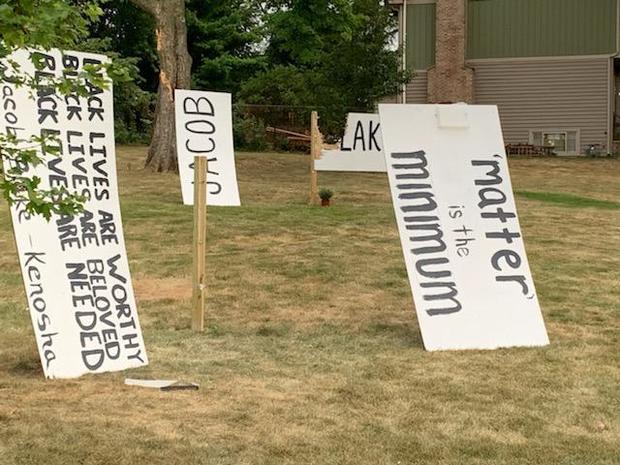 The August 2020 destruction of a Black Lives Matter sign placed in front of a Wheaton church where a Black and White congregation both worship prompted congregants to begin a racial reconciliation program.
The August 2020 destruction of a Black Lives Matter sign placed in front of a Wheaton church where a Black and White congregation both worship prompted congregants to begin a racial reconciliation program.
Suz Strauss
The sign was itself a replacement of a similar one that had been stolen days earlier. Hope parishioners Suz and Joe Strauss, a White couple, said they helped install the sign in solidarity with the Black community after watching in horror as George Floyd died beneath the knee of now-convicted ex-Minneapolis police officer Derek Chauvin. They left markers nearby to encourage residents to write messages of support. Some did, but others left messages of hate, slurs and a swastika. People would drive by and yell, “All Lives Matter.” Others threw dog excrement.
The couple knew Wheaton was conservative and predominantly White, but they never expected the sign would evoke such a response.
“We were just not expecting it to bring out that kind of hate and rage and racism right in our little bucolic community. I’ve never felt so violated,” said Suz Strauss. “I thought to myself: “Man, if I feel this way over a sign, imagine how Black people feel violated daily for their personhood.”
The shocking image of Floyd struggling for air beneath Chauvin’s knee was another wake-up call to the Strausses about the devastating impacts of systemic racism — and their own role in confronting it.
“As a White person, it was the first time I felt like…part of it was my knee,” Joe Strauss said. “I’ve got to take some responsibility because I’m in a position of power to help fix that brokenness.”
When a Bethel congregant shared Morrison’s book, the two church communities realized the path to healing could start close to home.
A friendship between pastors anchors a path forward
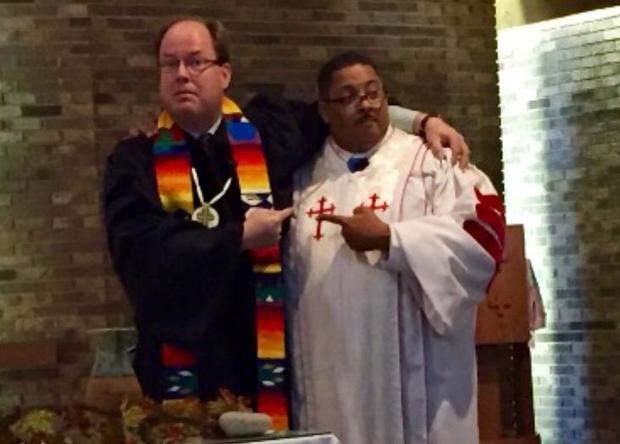 Rev. Dr. Jay Moses, pastor of Hope Presbyterian Church, left; and Rev. Dr. Ronald Beauchamp, Pastor of Bethel New Life Church, right.
Rev. Dr. Jay Moses, pastor of Hope Presbyterian Church, left; and Rev. Dr. Ronald Beauchamp, Pastor of Bethel New Life Church, right.
courtesy Ron Beauchamp
About 10 years ago, Beauchamp and Rev. Dr. Jay Moses crossed paths while both attending the Chicago Theological Seminary. It was the start of a friendship that, over the years, evolved into a journey exploring broader race relations and, more intimately, their commonalities — Baptist church upbringings and, more recently discovered, comic book collecting. Now the pastor at Hope, Moses, who is White, has shared with congregants that Beauchamp is his first Black friend.
It was nearly six years ago when Moses and Beauchamp discussed the idea of Bethel New Life sharing the space at Hope. Beauchamp had been holding church services from a hotel. The idea soon came to fruition, and they’ve worshipped in the same space since.
Although the congregations would see one another passing between each others’ Sunday services (Hope’s at 10 a.m. and Bethel New Life’s at 1 p.m.), they operated independently. At times, special celebrations—Palm Sunday brunch, World Communion Sunday and church picnics—brought the parishes together, but the coexistence skimmed the surface of a meaningful relationship.
“It was a friendship, but I never had a deeper dialogue with anybody,” Suz Strauss said.
The two church communities would later learn an important lesson espoused by Morrison through her racial reconciliation program: “Proximity doesn’t change you unless you have the difficult conversations,” Morrison told CBS News.
Though Morrison outlines a faith-based approach that’s been used by churches across the country, non-religious groups have used the program as well. Interest in it skyrocketed in 2020 following Floyd’s murder, which galvanized an international outcry against police killings of Black men and women and racial injustice.
Many who come to her program want to take action, Morrison says, but have no idea where to begin. “Be the Bridge,” she says, offers a roadmap.
Building a bridge through honesty, empathy
In Wheaton, three small “Be The Bridge” discussion groups would eventually take shape — two made up of members of Hope and Bethel, and a third the Strausses launched outside the church with White and Black community members. The Zoom meeting in March was an inaugural discussion for one of the church groups, with members from both churches meeting together for the first time.
White participants from Hope had already met separately, reading texts about topics like white privilege and the history of white supremacy in the U.S. Through Be the Bridge, White participants are encouraged to educate themselves about how racism has been systemic throughout societal institutions for centuries, and how White people often enjoy privilege — whether economic, educational, or through the health care or judicial systems — without realizing it. (Morrison cautions White participants new to the process not to rely on people of color to teach them, but instead on resources available through books and websites.) Hope participants described a self-reflection process that led them to recognize living in a “bubble,” insulated from everyday injustices experienced by people of color.
As the discussion began, White participants did more listening than talking, as Morrison suggests. Key to the program is to create a welcoming environment where people of color feel safe sharing how they have been harmed by racism.
Soon, painful stories emerged. Beauchamp shared that while the majority of people at Hope were welcoming at first, not all were.
He recalled icy stares and getting the “cold shoulder,” making him at times feel unwelcome.
“Those few stood out to us — they made themselves known to us, that they were not happy with us being there, not happy sharing common space,” Beauchamp said. “It became obvious to us.”
He started hearing from his congregants that they were experiencing the same thing. One of them, a Black man who was also participating in the discussion group, recalled asking Beauchamp, “‘Pastor, ain’t it time for us to get out of here?’ You can feel the tension, it was so thick you could cut it with a knife.”
Beauchamp said he recalled replying, “The Lord has a plan.”
Hope congregants were stunned that some Bethel congregants at first felt unwelcome. The revelation led members of both churches to tears, and a White congregant offered an emotional apology.
Morrison points to empathy and “lament” as one of the essential elements of her program — one that can often trigger deep emotion. “When we see ourselves as connected, and we see our brothers and sisters in pain, that person’s pain then becomes your pain,” Morrison said. “When you’re up close and personal sitting with someone, it creates that vulnerability and empathy….when you come wanting to be changed and desiring to see, when you hear those things it will penetrate every heart.”
Acknowledging and confessing wrongdoing and asking for and receiving forgiveness are also key parts of the racial reconciliation process, Morrison says. But she says the process can’t end with conversation. It must address how to make wrongs right, which requires a collective sense of responsibility to find solutions — even for those who haven’t personally participated in the harm. Ignoring that responsibility, Morrison says, is akin to saying, “My house isn’t on fire, so I have no responsibility to the people whose house is on fire in my neighborhood because I didn’t do it, I didn’t start it, and walk by.”
“Think about what that would seem like, look like, to the people being harmed,” Morrison said. “In silence, you contribute.”
New friends, a picnic and a seed planted
Milling about the covered entrance to the church nearly one year after the vandalism, women from both congregations unfolded a “Happy Juneteenth” banner. They were thrilled to find the party decor on such short notice, especially so soon after Juneteenth was signed into law as a national holiday. Together, they found just the right spot at the entrance to hang the banner commemorating the emancipation of African American slaves.
 Members of Hope Presbyterian Church and Bethel New Life Church, who share worship space in Wheaton, Ill., gathered for a Juneteenth picnic to mark the completion of a racial reconciliation program based on Latasha Morrison’s book, “Be the Bridge.”
Members of Hope Presbyterian Church and Bethel New Life Church, who share worship space in Wheaton, Ill., gathered for a Juneteenth picnic to mark the completion of a racial reconciliation program based on Latasha Morrison’s book, “Be the Bridge.”
Jennifer Taylor
The day’s combined church picnic was in stark contrast to the unattended food festival in the past. The group of about 30 members from both churches who participated in the Be the Bridge discussions were seeing each other in person for the first time since the pandemic relegated their meetings to Zoom. With chairs pulled into a circle and eating from their laps, members reflected on the transformation to a better understanding of others’ perspectives.
“It’s like I am meeting new friends,” said LaToya Gaddy, of Bethel New Life. “Friends that I never had before, no matter what color.”
Gaddy admitted she was nervous at first about the discussion groups. But as time went on, she saw participants confronting hurt they hadn’t been aware they were causing.
“Some people, you can bring that to their attention. Some people will rub it off [put it] off to the side and some people will actually take it in and use it as change,” Gaddy says.
For the two church communities, that change has focused on finding ways to ensure everyone feels welcome. For Beauchamp, the space where he was once offered the “cold shoulder” now feels like home. Small gestures like expanded office space for his staff have made a huge difference, he said.
Both pastors recognize more difficult work lies ahead, but they’re hopeful the program will expand. For Moses, the small gathering was symbolic of a movement being sowed in the hearts and minds of individuals—one at a time. He likens the Be the Bridge dialogue between the small groups to a tiny mustard seed—like the parable in the Gospel of Matthew.
“It’s just one mustard seed that can create a tree that all the birds of the air can sit in,” Moses says. “….You can force legislation, you can force civil rights, you can legislate it. But people coming together freely and sharing with vulnerability—that’s a mustard seed. That’s powerful.”
Video by Jennifer Taylor and Michael Roppolo.

